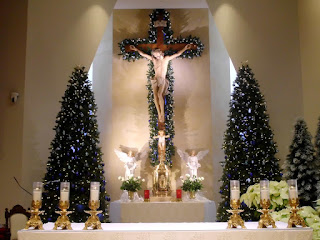The parish quickly outgrew the original church and sought to build a larger, new church. Fr. Joseph Zalibera, who would serve as pastor for 39 years, led the capital campaign and construction efforts.
The cornerstone of the edifice was laid in 1925 and the first Mass was on All Saints' Day, 1926, in the basement of the new church. Three hundred students were enrolled in the parish school that academic year.
Construction was not completed until Christmas Eve of 1929. A four-story school surrounded the church while a combination gymnasium/auditorium occupied the basement of the Byzantine-style church.
A pipe organ was installed in 1936 and Centerline Street, in front of the church, was renamed Saint Cyril Street. A parish high school was eventually built in 1945.
Both the elementary and high schools closed in 1971 and the parish petitioned the archdiocese to move to a new location. Permission was granted and the parish bought land at 18 Mile and Ryan Roads. Construction of the current edifice was completed in 1988 and the parish made the 13-mile move north to Sterling Heights.
The former SS. Cyril & Methodius Church was sold a Baptist congregation and occupied until the late 1990s. By 2000, all of the former buildings of the parish were abandoned, vandalized, and in disrepair. The City of Detroit sought to clear the desolate neighborhood to make room for an industrial park so, in early 2003, the former SS. Cyril & Methodius Church was demolished.
 |
| The former rectory, as it appeared in 2006, was later demolished - Source |
SS. Cyril & Methodius Parish celebrates its centennial this year. The parish will celebrate the anniversary with, among other things, a monthly Rosary in Slovakian and English. They are also in the process of gathering documents and artifacts from the parish history and will likely have some sort of exhibit later this year.
Outdoor Stations of the Cross stand across the parking lot from the current church.
An (Perpetual)Adoration Chapel is located near the main entrance, along with a set of four(five?) confessionals. The parish offers Reconciliation 30 minutes before each Mass and after the 9:00am Saturday Mass.
The parish patrons stand in the vestibule and, nearby, St. Francis of Assisi consoles Our Crucified Lord.
The Last Supper is depicted in the cryroom window.
Stained-glass windows divide the nave and vestibule.
Short, narrow windows line the walls near the altar.
The Holy Family stands at the left side of the church, near the organ.
The Sacred Heart of Jesus as well as St. Anne and Child Mary stand in corners of the nave.
St. Rita and the Infant of Prague stand in a back corner of the church; an icon and relics of the parish patrons in the chapel.
A large crucifix outside the main entrance; Guardian Angel and child outside the social hall.
St. Anthony of Padua stands in the hallway that connects the church and Fr. Mikus Hall. Our Lady of Fatima and the Angel of Portugal also stand in this hallway.
The Pieta rests outside the Fr. Mikus Hall.
A map of Slovakia hangs on the wall opposite the hall entrance.
Fr. Libor Marek was appoiunted pastor last July. He replaced Fr. Ben Kosnac, pastor for 15 years, after Fr. Kosnac was sent back to Slovakia at the end of April.


More info: parish website
More about the early history of the parish: Forgotten Detroit + Facebook
Photos of the demolition: Discuss Detroit forum






































No comments:
Post a Comment